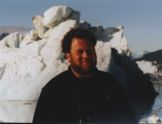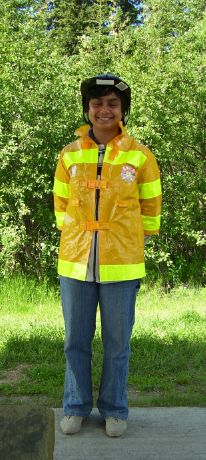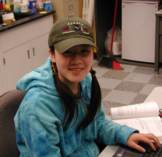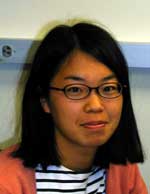Turbulence and Complex Systems
Group
Members
|
Name
|
Research Interests
|
Contact Information
|

David
Newman
|
- Dynamics and Control of SOC Systems
(Sandpiles, Power Transmission, Communications, Traffic, Plasmas)
- Basic Plasma and Fluid Turbulence
- The Interaction Between Sheared Flows and Turbulence
- Modeling Transitions in Plasma Transport
- Dynamics of Atomistic Flows in Carbon Nanotubes
- Development of Higher Order Characteristic Measures of Dynamical
Systems
|
- Phone: (907) 474-7858
- Fax: (907) 474-6130
- Address
- University of Alaska-Fairbanks
Physics Department
P.O. Box 755920
Fairbanks, AK 99775-5920
USA
- Office Rm.: 112 Natural Science Facility
E-mail: ffden@uaf.edu |
|
|
- Complex temporal
and spatiotemporal dynamics
- Modeling of biological systems
neuron
dynamics
coupled oscillators
circadian rhythms
population dynamics
- Stochastic dynamical systems
Influence
of noise/perturbations on nonlinear dynamical systems
- Nonlinear time series analysis
|
- Phone: (907) 474-6108
- Fax: (907) 474-6130
- Address
- University of Alaska-Fairbanks
Physics Department
P.O. Box 755920
Fairbanks, AK 99775-5920
USA
- Office Rm.: 106 Natural Science Facility
E-mail: ffraw1@uaf.edu |
|
Graduate Students
|

Debasmita Samaddar |
Turbulence modeling and the Interaction Between Sheared
Flows and Turbulence |
- Phone: (907) 474-1938
- Fax: (907) 474-6130
- Address
- University of Alaska-Fairbanks
Physics Department
P.O. Box 755920
Fairbanks, AK 99775-5920
USA
- Office Rm.: 111 Natural
Science Facility
E-mail: ftds1@uaf.edu |
Oralee Nudson |
Agent Based Modeling of Complex Infrastructures |
|
Seth Underwood |
Dynamics of Flows in Nanotubes |
|
Brian Wilson |
|
|
| |
|
|
|

Willis
Ferenbaugh
|
- Characteristic Measures of Dynamical Systems
|
- Phone: (907) 474-1938
- Fax: (907) 474-6130
- Address
- University of Alaska-Fairbanks
Physics Department
P.O. Box 755920
Fairbanks, AK 99775-5920
USA
- Office Rm.: 111 Natural
Science Facility
E-mail: chowdery@yahoo.com |
|
Graduated Aug. 2004 and relocated
to a land down under

Ryan
Woodard
|
|
- Phone:
- Fax:
- Address
- University of Alaska-Fairbanks
Physics Department
PO Box 755920
Fairbanks, AK 99775-5920
USA
- Office Rm.: 111 Natural Science Facility
E-mail: ryan@timehaven.org |

Jon Klaas
|
- Synchronization in Dynamical Systems (ie Biological systems)
|
- Phone: (907) 474-1986
- Fax: (907) 474-6130
- Address
- University of Alaska-Fairbanks
Physics Department
PO Box 755920
Fairbanks, AK 99775-5920
USA
- Office Rm.: 105 Natural Science Facility
E-mail: fsjpk@uaf.edu |

Safia Rawoot
|
- Transient Chaos in Multiple Topologies
|
- Phone: (907) 474-1986
- Fax: (907) 474-6130
- Address
- University of Alaska-Fairbanks
Physics Department
PO Box 755920
Fairbanks, AK 99775-5920
USA
- Office Rm.: 105 Natural Science Facility
E-mail: fssgr@uaf.edu |
| |
|
|
|
Current or recent Undergraduate
Students
|

Cheradan Fikstad
|
Power Systems Network |
|
Now at Dartmouth (Grad.
School in Physics)

John Broussard
|
- Dynamics of transport models with noise
|
E-mail: fsjcb1@uaf.edu |
Now at Univ. of Illinois (Grad. School in Physics)

Keiko Ino
|
|
E-mail: keikoroppi@hotmail.com |
Now at Dartmouth (Grad. School in Physics)

Sumire Kobayashi
|
- Interaction between chaotic species
|
E-mail: |
Visitors/Collaborators
| Abel
Bult |
IAB-UAF |
| Uma
Bhatt |
IARC-Frontier
at UAF |
| Ben
Carreras |
|
| Pat
Diamond |
UCSD |
Ian
Dobson |
UW-Madison,
ECE |
| Mark
Gilmore |
UCLA |
| Carlos
Hidalgo |
|
| Matt
Hitchman |
UW-Madison |
| Jean-Noel
Leboeuf |
UCLA |
| |
|
| Kenneth
Showalter |
West
Virginia University |
| |
|
| |
|
| Maria
Varela |
ORNL |
Boudewijn
Ph. van Milligen |
|
| Andrew
Ware |
Univ.
of Montana |
|
|
|
|
|
|
Former Students
|
Graduate Students
|
| Erin
Boyd |
IBM |
Ryan Woodard |
New Zealand |
| |
|
Undergraduate
Students |
Keiko Ino |
Univ. of
Illinios (Grad. School in Physics) |
Sumire Kobayashi |
Dartmouth
(Grad. School in Physics) |
John Broussard |
Dartmouth
(Grad. School in Physics) |
| Aaron
Boyd |
Univ.
of Colorodo - Boulder |
| David
Benbennik |
Cornell
University (Grad. School in Math) |
| Andy
Lester |
|
| Haiyin
Chen (at ORNL) |
|
Projects and Areas of Interest (more
coming)
1) Dynamics and Control of SOC Systems
(Sandpiles, Power Transmission, Communications, Traffic, Plasmas)
Motivated by the complicated dynamics observed in simulations and
experiments of gradient driven turbulent transport, a simple
paradigmatic transport model based on the ideas of self organized criticality
(SOC) has been developed and investigated . In many cases a strong coupling
exists between the turbulence and bulk flows in the system. If the bulk flows
are uniform the turbulence imbedded in the flow is simply advected and the dynamics
are usually not changed. Often however, such flows are spatially dependent (sheared)
and therefore can have an impact on the dynamics of the system. SOC systems
have been the focus of much investigation recently due to the broad relevance
of many of the characteristics of these systems. For example, 1/f noise is a
ubiquitous feature in many diverse physical systems from starlight flicker through
river flows to stock market data. Additionally many of these systems (and others)
exhibit a remarkable spatial and temporal self-similar structure. The physical
and dynamical self-similarity that is exhibited by these systems is very robust
to perturbations and is not necessarily close to any "linearly marginal" state
such as the angle of repose for a sandpile. It is this self-similarity and non
linear self organization that leads to the term "Self-Organized Criticality".
In many systems (magnetically confined plasmas for example) the transport of
constituents down their ambient gradient is thought to be dominated by turbulent
transport. That is a turbulent relaxation of the gradient. The turbulence itself
is often driven by the free-energy in the gradient . It is this combination
of turbulent relaxation removing the source of free energy thereby turning off
the turbulence which then allows the gradient to build back up which allows
the development of robust (albeit fluctuating) profiles. The dynamics of such
systems can be computationally investigated with a cellular automata model of
a running sand pile. This model allows us to investigate the major dynamical
scales and the effect of an applied sheared flow on these dominant scales. In
addition to allowing the paradigmatic investigation of turbulent transport,
the introduction of sheared flow (wind) and the determination of transport coefficients
in sandpiles, both of which naturally arise in the context of magnetically confined
plasmas, act as a novel and important extension to the chaotic dynamics of SOC
systems.
Recent papers in this area (in PDF format)
Power systems (HICSS2001 Data
analysis paper 1 , HICSS2001 Modeling
paper 1 , HICSS2001 Modeling paper
2 , HICSS2002 modeling paper 1 , HICSS2002
modeling paper 2 )
Communications systems ( HICSS2002 Modeling
paper 1)
Basic SOC systems
Plasmas
2) The Interaction Between Sheared Flows and Turbulence
3) Basic Plasma and Fluid Turbulence
Investigations of the basic dynamics of the turbulent systems can
shed light on both interesting nonlinear dynamics and real systems.
4) Modeling Transitions in Plasma Transport
Transitions to enhanced confinement regimes are very important for
the success of the fusion energy program.
5) Dynamics of Atomistic Flows in Carbon Nanotubes
In nature the interaction between fluid flows and surfaces and the
resultant transport due to the flows is both ubiquitous and of fundamental importance.
One of the flow regimes of particular interest is that in which the fluid transitions
to a turbulent flow. In this case, the transport characteristics and flow dynamics
change dramatically. In addition to an enormous amount of attention given to
these systems, much progress has been made in recent years on modeling and understanding
the dynamics of these continuous fluid flows (CFD) using the Navier-Stokes equations.
However, with the ever-increasing interest in smaller size devices (for example,
in MicroElectroMechanicalSystems - MEMS applications) an interesting new regime
is encountered. This is the regime in which the distance between surfaces becomes
comparable to the atomic or molecular sizes of the flowing material. While the
highly "viscous" flow through irregular microporous materials has been extensively
studied the basic underlying physics of the "fluid" dynamics of flows through
"smooth" regular structures on this scale have yet to be characterized. In particular,
the demonstration and characterization of transitions in flows on these scales
will have a profound impact on the development of the new blossoming capabilities
in building micro and nano scale devices and structured materials.
A relevant yet simple realization of such a flow is that given by atoms flowing
through carbon nanotubes. Typically, in nano scale systems, the effective
viscosity is expected to be high unless, perhaps, the flow "channel" is very
regular and smooth such as that found inside a carbon nanotube, for example.
Investigation of these "atomistic" flows is of interest for the obvious reason
that one must understand how material flows in these nanotubes if one wishes
to use them. More importantly the demonstration of new flow dynamics with
transitions within the tube could lead to altogether new uses. In addition,
basic understanding of flows on these scales may be of relevance in the extreme
boundary layer of continuous (Navier-Stokes) flows and may help in the design
of special coatings, for example, to decrease (or increase) drag. It should
be stressed that the novel aspect of this is not simply the nanoscales in
the system, but rather the interaction between the atomistic flow and the
very regular surface created by the nanotubes etc. This research project,
which is on the cutting edge of the burgeoning field of nanotechnology, can
at the same time make fundamental contributions to the underlying basic physics.
6) The Effect of Noise on Propagation in Reaction-Diffusion Equations
7) Development of Higher Order Characteristic Measures of Dynamical Systems
Support from DOE under grants DE-FG03-99ER54551 and DE-FG03-00ER54599 (a young
investigator award) and NSF under grant ECS-0085647 are gratefully acknowledged
Professional links of interest
Other links of interest
PDF file format
Many of the papers found on these pages are in pdf format. To find out more
about pdf viewing or to get a free viewer for pdf documents see Adobes
Acrobat Reader (for Macintosh(R), IBM AIX, Windows(R), Sun(TM)
SPARC(R), HP/UX(TM), Silicon Graphics(R) and others) or Xpdf
(for x86 - Linux 2.0 ELF , PowerPC - AIX 4.1 , SPARC - SunOS 4.1.3 , MIPS, Ultrix
4.4 , Alpha - OSF/1 3.2 , HP-PA, HP-UX 9.05 , and others).

 Hits
since 3 June 2002
Hits
since 3 June 2002
Last changed on
28 January, 2008
.
This page is maintained by David Newman










